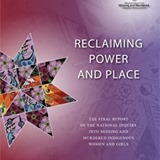 Part 2a of Chapter 8: Right to Justice looks at the third pathway to violence, identified at Lack of Will and Insufficient Institutional Resources.
Part 2a of Chapter 8: Right to Justice looks at the third pathway to violence, identified at Lack of Will and Insufficient Institutional Resources.
Earlier, pathway Intergenerational and Multigenerational Trauma noted that under-reporting of violence by Indigenous women is related to racist and sexist stereotypes they face.
Pathway Social and Economic Marginalization noted that Indigenous women are over-presented in Canadian prisons and that is tied to colonization with causes of poverty, violence, family disruption, mental health issues and addictions not adequately addressed.
Lack of Will and Insufficient Institutional Resources: Police apathy has been recognized in many cases involving violence against Indigenous women and girls. Many families shared testimony of how stereotypes and victim blaming slowed or impeded investigations of loved ones’ disappearances or deaths. Many police services also spoke to the need to be properly resourced.
Personal note: I called the Edmonton Police Service several times in 1997 after my daughter disappeared, assuming that my calls were somehow documented. I will never forget a few days later when I called to ask what was happening with her case only to be told “there is no file.” I insisted on an official report and was finally given a file number. “OK, now what happens?” I asked only to be told, “Now we wait for a body.” I learned later that EPS had only one officer assigned to Missing Persons at the time. Nevertheless, it was an indictment of the whole service that such a callous and indifferent response could be given to the mother of a missing child. My story is simply one of many and my heart goes out to all the families across Canada who were similarly dismissed.
DEEPER DIVE: The Sex Industry, Sexual Exploitation, and Human Trafficking (p.656)
Constructing an accurate picture of the number of Indigenous woman and girls in the sex industry is difficult due to long-standing views that those individuals are disposable or unworthy of attention.
Understanding Diverse Perspectives: Some women insisted that sex work by its very nature is exploitative; others felt criminalization made women more vulnerable to violence. Consensus was that serious attempts to combat sexual exploitation of youth needed adequate financial, health and social supports.
The Statistical Realities of Human Trafficking in Canada: While realities are hard to measure, victims are most often young women who may be afraid to report for a number of reasons.
Entry into Human Trafficking: Many of the girls and women in the sex industry have experiences of childhood abuse, violence, and trauma which may impact their vulnerability to exploitation. “Grooming” is a process whereby predators target and prepare children and young people for sexual exploitation. Recruitment areas include outside group homes, bus depots, hitchhiking, etc. Poverty, homelessness, and addiction are factors for many girls and women trading sex for basic needs, a practice often referred to as “survival sex.” Others described their involvement as “empowering” in that sex work provided financial benefits they would not have had otherwise.
Confronting the Sex Industry and Institutionalized Violence: Bill C-36, the Protection of Communities and Exploited Persons Act (PCEPA) came into force on Dec 6, 2014. The PCEPA treats prostitution as exploitative and seeks to reduce it by penalizing those who purchase sex. Some suggest the legislation is not enough to counteract racist and sexist stereotypes about Indigenous women and indifference towards them, and so continues to put adult sex workers at risk.
Searching for Justice: For families whose loved ones were involved in the sex industry at the time of their disappearance or death, encounters with the police and justice system often involved sexist, racist, and discriminatory attitudes. The loved one’s “lifestyle” was often used to excuse inaction on the part of the police, while family information about the person’s predictable behaviors or history was dismissed. Other examples described court hearing where woman were referred to by stigmatizing stereotypes rather than by name.
Searching for Security: Women and girls involved in sex work talked about strategies they use to enhance safety in the absence of protection from police. The relationships among Indigenous people in the sex industry challenges colonial policies that seek to undermine the structure of family. They establish “families of the heart” to offer each other protection, love, and connection.
Recognizing Experience and Expertise, and Redefining Justice and Security: Witnesses made clear that justice and security depend on recognizing the agency and expertise held by women themselves to create just communities and relationships. Survivor-led initiatives are essential. Supports that would enhance safety include: safe spaces to engage in sex work, access to services such as health care, counselling, addictions and legal services, opportunities to learn traditional culture, and improved response from the police. Socio-economic barriers also need to be addressed to that sex work is not seen as the only way out of poverty. Stigmatization and lack of long-term funding were also seen as barriers to services.
A New Vision for the Future: By valuing the expertise of those with lived experience, it is possible for systems to be created that recognize people involved int the sex industry as worthy of protection, safety, and love. Every life is of value.
Findings:
- The detection of offenses such as human trafficking and sexual exploitation is difficult, compounded by difficulties in investigating and prosecuting these crimes. Current laws are not effective in increasing safety overall because they do not acknowledge power imbalance and social stigma.
- Indigenous people in the sex industry do not trust police services to keep them safe, due to the criminalization of their work and the discrimination they encounter.
- The rights to safety and security of Indigenous women in the sex industry are not being recognized and protected.
Personal Note: It appears much of the testimony given related to experiences prior to the Protection of Communities and Exploited Persons Act, enacted December 2014. It is true that women were historically stigmatized and criminalized for their involvement in commercial sexual exploitation. PCEPA represents a dramatic shift in that it focuses on consumers. It is unfortunate that the federal government changed shortly after PCEPA. The legislation was then labelled as partisan by some and so remains largely untested as it was not developed and enforced across Canada. Of course, best practices in combatting sexual exploitation recognize that legislation and enforcement must be accompanied by other initiatives such as education and awareness, curbing demand, educating men, training for law enforcement, raising political awareness, peer support, exit strategies, media campaigns, and extensive services for victims.
Further law enforcement issues are identified under Lack of Will and Insufficient Institutional Resources, enough that they will be discussed in a separate blog, Part 2b.

